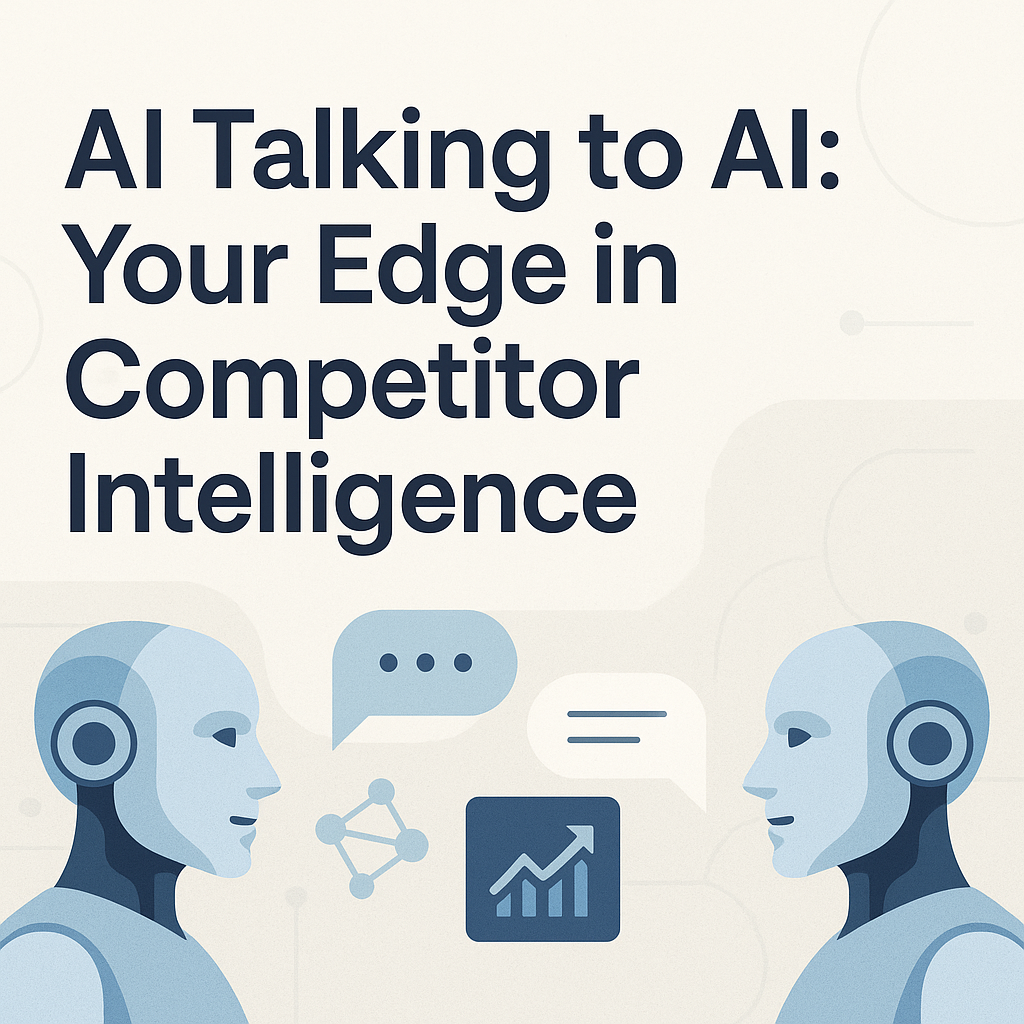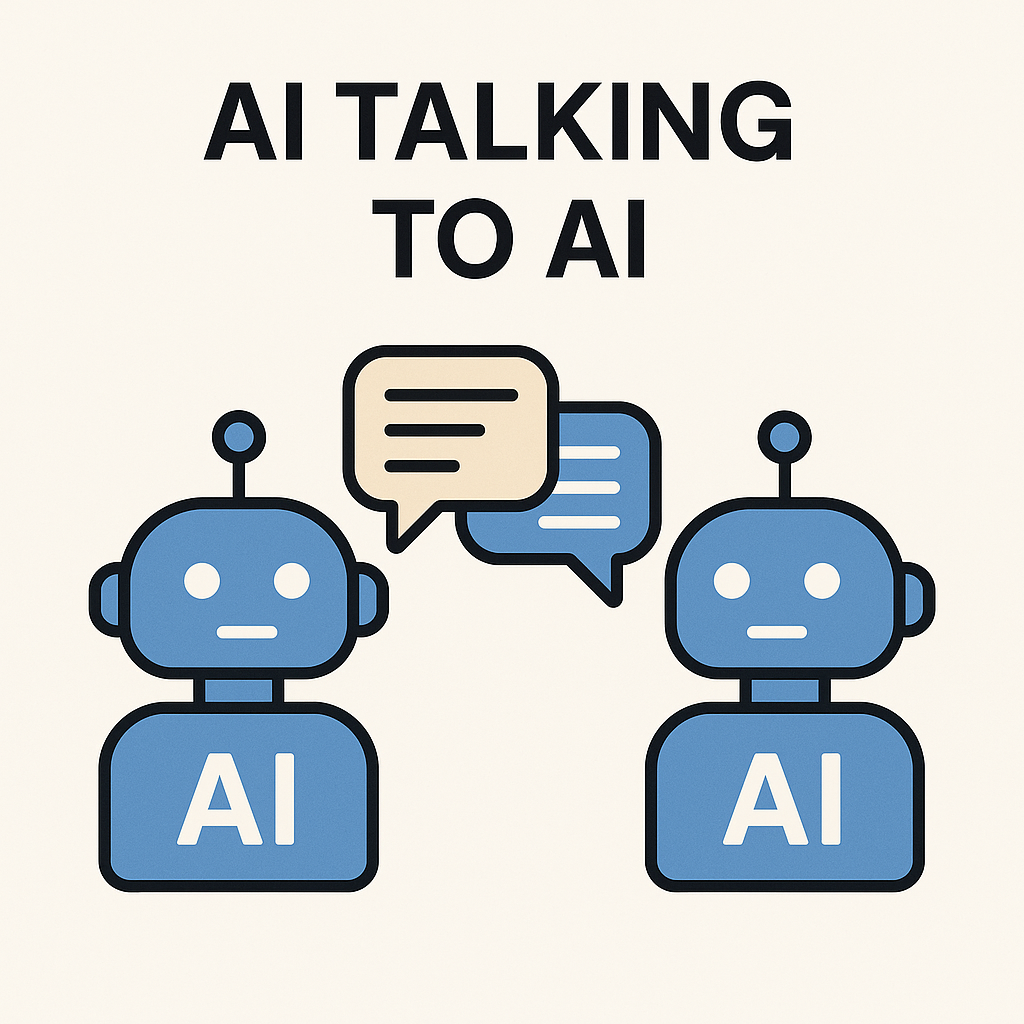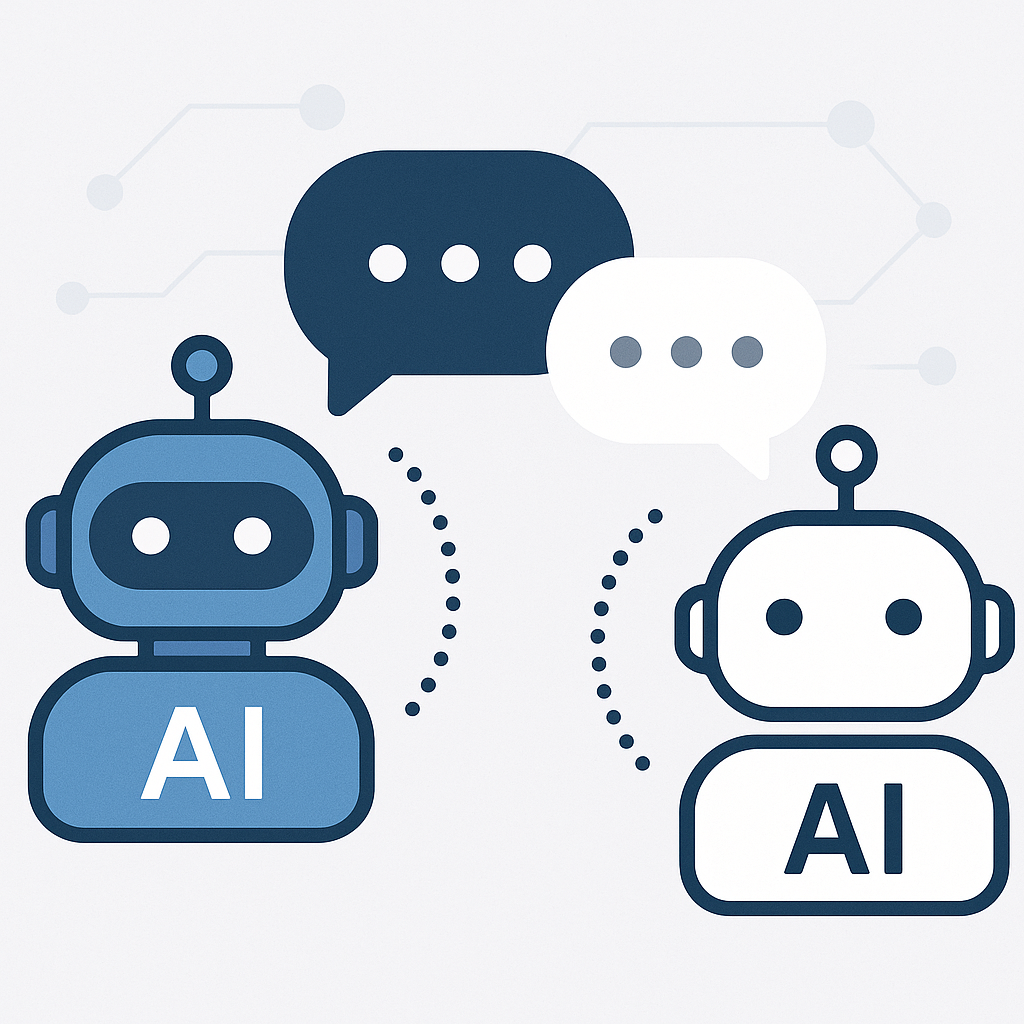AI Talking to AI: Your Edge in Competitor Intelligence

In today's hyper-competitive business environment, staying ahead isn't just about having a great product or service; it's about understanding the intricate dance of the market. We're constantly looking for an edge, a clearer view of what our rivals are doing, planning, and executing. But what if the very tools we use to analyze the market could be enhanced by a new paradigm? Enter the fascinating concept of 'AI talking to AI,' a sophisticated approach that's quietly revolutionizing how we gather and interpret competitor intelligence, particularly when it comes to understanding complex communication strategies.
Imagine a scenario where artificial intelligence systems are not just tools for human analysts, but are also capable of processing and understanding the outputs of other AI systems – whether that's marketing content, automated customer service interactions, or optimized outreach campaigns. This isn't science fiction; it's the cutting edge of how businesses can leverage advanced technology for deeper insights. This article will dive into how 'AI talking to AI' empowers businesses with unparalleled competitor intelligence, focusing on how this technology can dissect competitor email strategies, uncover market trends, and provide a significant strategic advantage. We'll explore the practical applications, the benefits for productivity, and how you can harness this power to sharpen your own business communication and market positioning.
Why Competitor Intelligence is Crucial in Today's Market
In the relentless pursuit of growth and market share, competitor intelligence (CI) is no longer a nice-to-have; it's a fundamental necessity. Businesses that understand their competitive landscape are better equipped to anticipate market shifts, identify opportunities, and mitigate threats. Without robust CI, companies risk being blindsided by competitor moves, losing customers to more agile rivals, or investing resources in strategies that are already obsolete.
Consider the sheer volume of data generated daily by businesses worldwide. Marketing campaigns, product updates, customer service interactions, pricing adjustments – all these activities paint a picture of a competitor's strategy. However, manually sifting through this information is like trying to drink from a firehose. This is where AI steps in. AI can automate the collection and initial analysis of vast datasets, identifying patterns and anomalies that human analysts might miss. As competitive intelligence tasks are being transformed by AI, the ability to gain timely, actionable insights becomes paramount. Understanding competitor strategies allows businesses to:
- Identify Market Gaps: Spotting underserved customer segments or unmet needs that competitors are not addressing.
- Refine Product Development: Learning from competitor successes and failures to improve your own offerings.
- Optimize Pricing and Promotions: Benchmarking against competitor strategies to ensure competitive pricing.
- Enhance Marketing and Sales Efforts: Understanding what resonates with customers in your industry and adapting your outreach.
- Anticipate Strategic Shifts: Predicting competitor moves based on their communication patterns and investments.
Failing to invest in comprehensive competitor intelligence is akin to navigating treacherous waters without a map. It leaves your business vulnerable and limits its potential for sustainable growth.
How AI Analyzes Competitor Communications: The 'AI Talking to AI' Approach
The concept of 'AI talking to AI' in the context of competitor intelligence refers to the sophisticated application of AI systems to analyze and interpret data generated by other AI systems or AI-driven processes. It's about AI understanding and deriving meaning from the output of artificial intelligence in the marketplace. This isn't about two chatbots having a philosophical debate; it's about one AI system processing and learning from the communications and strategies deployed by another entity's AI-powered operations.
Think about it: many modern business communications are already heavily influenced or entirely generated by AI. This includes AI-powered email marketing platforms, automated customer service chatbots, personalized recommendation engines, and dynamic ad creatives. When we talk about 'AI talking to AI' for competitor analysis, we mean using AI tools to:
- Deconstruct AI-Generated Content: Analyzing the language, tone, structure, and calls-to-action within emails, social posts, or website copy that were likely crafted or optimized by AI.
- Identify Algorithmic Patterns: Detecting patterns in communication frequency, timing, segmentation, and personalization that suggest underlying AI-driven strategies.
- Interpret AI-Driven Customer Interactions: Analyzing transcripts of competitor chatbot conversations or AI-powered customer support logs to understand how they handle inquiries and manage customer sentiment.
- Uncover Automated Campaign Logic: Inferring the logic behind competitor marketing campaigns by observing their consistent execution and adaptation across various channels.
For instance, an AI system could process thousands of emails from a competitor. It wouldn't just read the text; it would analyze the subject lines for effectiveness (implied by open rates or A/B testing patterns), the sentiment of the content, the types of offers made, the frequency of communication, and the underlying personalization techniques. This analysis helps uncover the competitor's *strategy* as executed by their own AI marketing tools. As noted in Communications of the ACM, when AI agents collaborate or are analyzed together, they can reveal deeper insights, and this principle extends to analyzing competitor AI outputs: "They worked with the AI together, sharing prompts, comparing responses, debating interpretations, building on each other’s insights." This highlights the power of AI-driven analysis, even when the 'conversation' is one-sided, observing the output of another AI.
This sophisticated form of analysis allows businesses to move beyond surface-level observations and understand the *intelligence* and *strategy* embedded within competitor communications, effectively turning AI's output into actionable intelligence for your own benefit.
Leveraging AI for Email Competitor Analysis: Identifying Key Strategies
Email remains a cornerstone of business communication and marketing. For competitor intelligence, analyzing competitor email strategies can reveal invaluable insights into their customer engagement, sales tactics, and overall market approach. This is where the 'AI talking to AI' concept truly shines, particularly for busy professionals looking to boost their conversational analytics and email productivity.
AI can process and analyze competitor emails at a scale and speed that is impossible for humans. By focusing on email strategy analysis, AI can help identify:
- Subject Line Optimization: AI can analyze patterns in successful subject lines, identifying keywords, lengths, and emotional triggers that elicit higher open rates. This can inform your own subject line A/B testing.
- Content Segmentation and Personalization: By analyzing variations in emails sent to different lists or seemingly different customer profiles, AI can help infer how competitors are segmenting their audience and what personalized content resonates.
- Call-to-Action (CTA) Effectiveness: AI can identify the most common, prominent, and potentially effective CTAs used by competitors, helping you understand their conversion goals and tactics.
- Tone and Voice: AI can perform sentiment analysis on email copy to determine if a competitor adopts a formal, informal, urgent, or empathetic tone, which reflects their brand positioning and customer relationship strategy.
- Promotional Cadence and Offer Types: AI can track the frequency of promotional emails, the types of discounts or offers presented, and how these change over time, indicating sales cycles and promotional strategies.
- Onboarding and Nurturing Sequences: By analyzing the series of emails a new subscriber receives, AI can map out competitor customer journey maps and identify their lead nurturing strategies.
Consider a scenario where a competitor's AI marketing system consistently sends out personalized emails that reference past purchases or browsing history. An AI analysis tool could detect this pattern, identify the specific data points likely being used for personalization, and flag it as a key strategy. This insight allows you to evaluate your own personalization efforts and potentially invest in similar capabilities. The speed and efficiency gained from AI in this process are significant, as explained by AI-driven competitive intelligence monitoring, which highlights automated data collection and speed as key benefits.
By applying AI to competitor email communications, you can gain a granular understanding of their outreach playbook, enabling you to adapt and improve your own email strategy for better engagement and conversion.
Actionable Insights: Turning AI-Driven Analysis into Competitive Advantage
The true power of 'AI talking to AI' for competitor intelligence lies not just in the data gathered, but in transforming that data into actionable strategies. The insights derived from AI analysis of competitor communications should directly inform your business decisions, giving you a tangible competitive edge.
Here’s how to translate AI-driven analysis into practical advantages:
- Refine Your Value Proposition: If AI analysis reveals that competitors are heavily emphasizing a specific benefit or feature in their communications, it's a signal that customers in your market value it. Ensure your own messaging clearly articulates how you meet or exceed that need.
- Optimize Engagement Cadence: Understand the frequency and timing of competitor outreach. If they're engaging customers daily with valuable content, you might need to increase your own communication touchpoints. Conversely, if their frequent emails lead to fatigue, you can opt for a more strategic, less frequent approach.
- Enhance Personalization Tactics: AI can uncover the sophistication of competitor personalization. If they are segmenting based on nuanced behavioral data, it's a cue to invest in more advanced CRM and marketing automation tools to achieve similar or better results.
- Improve Offer Strategy: Analyze competitor discount patterns, bundle offers, or loyalty programs identified by AI. This can help you craft more competitive pricing strategies or unique promotional campaigns.
- Strengthen Your Content Strategy: By understanding the topics, formats, and tone that competitors are successfully using (as identified by AI analysis of their content), you can refine your own content calendar and editorial focus to capture audience attention more effectively.
- Identify Emerging Trends: AI can spot subtle shifts in competitor messaging or new tactics they are employing, allowing you to be an early adopter of successful strategies or to counter emerging threats proactively.
For example, if AI flags that a competitor is consistently using urgency in their email CTAs (e.g., "Limited time offer," "Sale ends tonight"), and this correlates with increased engagement metrics (if inferable), you might decide to incorporate more time-sensitive elements into your own campaigns. This isn't about copying; it's about informed adaptation. As Forbes points out regarding AI's competitive advantage, small businesses can leverage AI to modernize their operations and gain an edge, and competitor analysis is a prime area for this.
By systematically applying AI-generated insights, you can make data-driven decisions that enhance your market position, improve customer engagement, and ultimately drive business growth.
MailToPie's Role: Enhancing Your Email Productivity with AI-Powered Competitor Insights
While analyzing competitor communications provides the intelligence, effectively acting on it requires efficient internal processes. For busy professionals, managing your own email communications and workflow is critical. This is where advanced AI tools become indispensable, helping you not only stay organized but also leverage competitive insights more effectively.
Gaining a strategic edge through competitor analysis means freeing up your time and mental bandwidth to focus on strategy and execution. Tools that enhance your own email productivity directly contribute to your ability to benefit from market intelligence. For instance, a modern ai executive assistant can help streamline your workflow, manage your inbox efficiently, and even assist in crafting competitive responses or internal reports based on the intelligence you gather.
Consider using an ai executive assistant to manage your email communications and free up mental bandwidth for higher-level tasks. These tools can automate repetitive tasks, prioritize your inbox, and ensure you don't miss critical communications, whether from clients, internal teams, or competitive intelligence updates. By leveraging an ai executive assistant, you can efficiently process and act upon the insights derived from sophisticated competitor analysis, ensuring your own communication strategies are sharp and responsive.
Ultimately, integrating AI for both competitive analysis and personal productivity creates a powerful feedback loop. You gain intelligence, and you use AI tools to implement your strategies more efficiently, further enhancing your competitive advantage. Explore how AI email solutions can help you master your inbox and support your strategic initiatives.
Challenges and Ethical Considerations in AI-Driven Competitor Intelligence
While the prospect of 'AI talking to AI' for competitive advantage is exciting, it's crucial to approach this domain with awareness of its challenges and ethical implications. Responsible implementation is key to long-term success and maintaining business integrity.
Challenges:
- Data Volume and Quality: Analyzing vast amounts of competitor data requires robust AI infrastructure and sophisticated algorithms. Ensuring the quality and relevance of the data is paramount, as flawed data can lead to inaccurate insights.
- Interpretation Nuance: AI excels at pattern recognition but can struggle with subtle nuances, sarcasm, or contextual understanding that a human analyst might grasp instinctively. Over-reliance on AI without human oversight can lead to misinterpretations.
- Dynamic Market Changes: Competitor strategies can shift rapidly. AI models need to be continuously updated and retrained to keep pace with evolving market dynamics and competitor tactics.
- Technical Expertise: Implementing and managing advanced AI analysis tools requires specialized skills, which may be a barrier for some organizations.
Ethical Considerations:
- Data Privacy and Legality: It is critical to ensure that all data collection and analysis are conducted ethically and legally. This means adhering to data privacy regulations (like GDPR or CCPA) and only analyzing publicly available information or data obtained with explicit consent. Scraping private or protected data is unethical and illegal.
- Avoiding Misinformation: AI can sometimes generate or amplify misinformation if not properly monitored. It's important to verify AI-generated insights and ensure they are based on factual data.
- "Training Your Competitor's AI": A cautionary note from the ACM article, "Stop Training Your Competitor's AI," suggests being mindful of how your own digital footprint might inadvertently train competitor AI systems. While this article focuses on analyzing competitor AI, the principle of data stewardship applies to your own operations.
- Bias in AI: AI models can reflect biases present in their training data. This could lead to skewed analysis of competitor strategies or customer segments. Regular auditing and bias mitigation techniques are essential.
Navigating these challenges and ethical considerations requires a balanced approach, combining the power of AI with human judgment, strategic oversight, and a commitment to responsible data practices. As TechRadar has discussed, the interaction between AI systems, while fascinating, also necessitates careful management and understanding of their outputs and potential behaviors.
The Future of AI in Business Communication and Competitor Analysis
The evolution of AI in business communication and competitor analysis is far from over. As AI capabilities continue to advance, we can expect even more sophisticated applications that will further transform how businesses operate and compete.
Looking ahead, the 'AI talking to AI' paradigm will likely evolve into:
- Predictive Competitor Modeling: AI systems may become capable of not just analyzing past and current competitor actions but also predicting future strategies with higher accuracy, based on complex pattern recognition and simulation.
- AI-Driven Strategy Generation: Instead of just providing insights, AI could potentially suggest or even auto-generate strategic responses to competitor moves, optimizing your business's agility.
- Cross-Channel Communication Synthesis: AI will become more adept at synthesizing intelligence from disparate communication channels (email, social media, advertising, customer service logs) to form a holistic view of a competitor's market presence and strategy.
- Enhanced Inter-AI Collaboration for Analysis: Future tools might involve multiple AI agents working collaboratively to analyze competitor data, each specializing in different aspects of communication or market intelligence, much like a human team.
- Real-time Market Simulation: AI could potentially create dynamic simulations of market scenarios, allowing businesses to test their strategies against AI-driven representations of competitor behavior before committing resources.
The ongoing development in AI workflow and business communication AI promises a future where staying ahead of the competition is more data-driven, efficient, and intelligent than ever before. Professionals who embrace these advancements will be best positioned to navigate the complexities of the modern business landscape and secure a lasting competitive advantage.
Conclusion:
The advent of 'AI talking to AI' in competitor intelligence offers a powerful new lens through which businesses can understand their market. By leveraging AI to analyze the communications and strategies of competitors, particularly their email outreach, companies can uncover invaluable insights, identify emerging trends, and refine their own approaches. This sophisticated form of analysis not only deepens strategic understanding but also drives operational efficiency. Coupled with AI tools that enhance personal productivity, such as an ai executive assistant, professionals can manage their workloads more effectively, freeing up time to implement these game-changing insights. As this technology continues to mature, embracing AI for competitor analysis is no longer an option, but a strategic imperative for any business aiming to thrive in a competitive world. Start exploring how AI can illuminate your competitive landscape today.
```


